Events of Friday 1st May 2015
In the afternoon, Aung and I travelled together on Air Bagan Flight W9-424 from Putao to Mandalay with an intermediate stop at Myitkyina. At Mandalay, I disembarked whilst Aung stayed on the flight to return to his home in Yangon. The transfer bus at Mandalay was a very second hand Japanese bus. In the large baggage hall, we waiting some minutes before one on the baggage conveyors started up and started spitting out bags intermittently. I stood despondently as the waiting crowd thinned out having found their bags until I was alone and no more bags emerged. Then, a member of staff came sauntering up pushing my bag which, for some reason, had not been through the baggage conveyor. Once they'd collected my baggage tag, I was able to have all my luggage X-rayed and move into the arrivals hall where I'd spotted my waiting driver. He recognised me and said he'd driven me before. He was driving an air-conditioned Toyota 'Alphard' and, for once, I didn't complain about the air conditioning.
Myanmar is changing quite quickly in some respects. The dual carriageway leading away from the airport has sprouted regular posts which I assume will shortly be fitted with lights. At one of the many traffic islands, a huge filling station is under construction. At one point, extensive blocks of what looked like apartments are being built. At the junction with the road to Sagaing, we took the right fork for Mandalay but, in the background, I could see the silhouette of the Sagaing Hills with the triple arches of the new road bridge. As we approached the city, we passed a toll station which relieved us of 500 kyat (about half a U.S. Dollar) after which are area became built up with commercial and industrial premises lining the dual carriageway. As we came nearer, the traffic sloowed, giving me time to notice large new cantilevered structures carrying traffic lights. I noticed the rather mis-named Prince Airport Hotel - it had taken us 30 minutes from the airport to pass the hotel. As we continued, the shops seemed to be more up-market fashion stores and lots of mobile phone stores. Having passed the railway station, we turned right to run parallel to part of the moat around the former royal palace. Very soon, we were pulling into the forecourt of the Sedona Hotel.
Fortunately, I was expected so, within a few minutes, I was in a comfortable room at the front on the 5th floor, with a splendid view along the palace moat to Mandalay Hill in the background. Rooms at the front are noisier, but I think I prefer the front for the commanding views. I'm at the Sedona for two nights, then I fly back to Yangon for the last segment of my trip before returning to England.
I'm afraid there's been too much going on to write up all that's happened but, sooner or later (probably later) I'll try to complete the story and add pictures.
All my posts on this trip to Myanmar can be found here.
Friday, 1 May 2015
Putao (Part 2)
Events of Wednesday 29th April 2015
We’d arranged to explore the Market at around 7 o’clock in the morning.
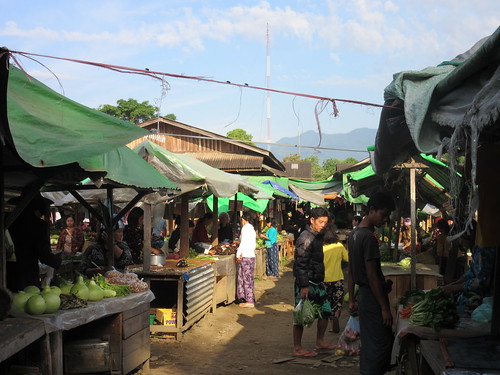 Putao Market.
Putao Market.
With appetites whetted by the walk, we returned to Putao Trekking House for breakfast. They’d laid on white toast with butter and preserves followed by a plain omelette for me. They couldn’t resist following that with a pancake and honey. I have to admit, the pancake was very good.
After breakfast, we set off on the main feature of the day – a trek of around ten miles to Namkhan Village. I’d loaded my backpack with clothes and essentials for one night’s stay at a guest house at our destination. We initially set off in the Toyota – Aung, the Local Guide, the driver and two young men who travelled in the luggage space at the back and whose function wasn’t immediately clear.
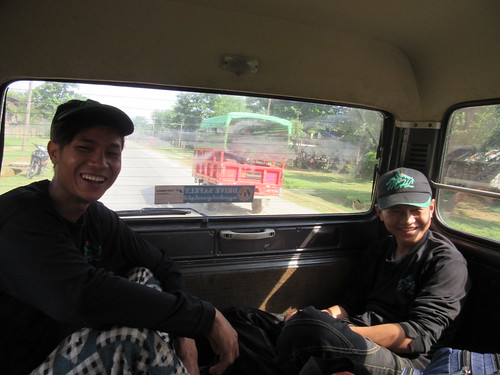 The two young men who accompanied us to Namkhan.
The two young men who accompanied us to Namkhan.
After a few miles, we stopped at a small village of bamboo houses, picked up our backpacks and began our trek by walking through the village to the pretty, rolling wooded countryside beyond. We crossed a number of narrow pedestrian footbridges made of bamboo but there appeared to be fords adjacent so that motor vehicles could also follow the track. In other places there were wider, rather ramshackle, bridges which presumably could support a light vehicle. It became hotter but I knew that the first ‘leg’ would only be an hour. We arrived at another small village where we joined a tarmac road and continued over the brow of a hill, where a river crossed by a suspension bridge could be seen, with a golden pagoda on the opposite bank gleaming in the bright sun.
The suspension bridge appeared to be of local design. The two orange-painted towers on opposite banks were reinforced concrete and the ends of the suspension cables were anchored to substantial concrete blocks. The actual bridge deck was fabricated from modular ‘Bailey’ bridge parts with the road surface in timber. On either side of the bridge deck there were ‘horizontal catenary cables’, anchored to smaller concrete blocks. These cables were then connected to the bridge deck every few yards by smaller cables. The function was presumably to counter horizontal sway of the deck, but it’s a feature I’d not previously seen (although we crossed a number of similar bridges later in the trip).
As we walked across the bridge, a painful groaning came from the far bank, where one of the ubiquitous Chinese-made heavy lorries was struggling along a track which led from the river bank to the road we were on. When we reached the far bank, the lorry had parked and the driver and his mate were on the ground examining the rear axle. The lorry was loaded (or more probably overloaded) with stone and, from the noises it was making earlier, they were right to be concerned.
Next to the parked lorry was a small tea house where we paused for refreshment. We left our back packs in the restaurant and walked a few hundred yards to the pagoda we’d seen from the top of the hill – Kaung Mu Long. Major reconstruction work was in progress and although it looked new, it’s on a very ancient site. Outside the pagoda was a display of photographs and plans detailing the reconstruction. I was fascinated by all the trades involved in completing the work. The approaches to the pagoda were via steps covered in marble slabs and two smiling women were mixing grouting cement and grouting the gaps between the marble slabs. In various places, men were painting different features in gold, white or coloured paints. The hardest work was being carried out by a group of women working on the river bank below us who were involved in the protection of the river bank against erosion. Large rectangular wire cages called gabions were being filled with round stones carried from the shore manually. I noticed a ‘CAT’ packaged standby generator at the base of the pagoda to power the various electric lights which were still being wired.
I'm afraid there's been too much going on to write up all that's happened but, sooner or later (probably later) I'll try to complete the story and add pictures.
All my posts describing this trip to Myanmar can be found here.
My pictures
The following albums (on Flickr) hold pictures relevant to this post:-
Putao.
Trekking in Kachin State.
Kaung Mu Long Pagoda.
Trekking to Nang Kham Village.
Nang Kham Guest House.
All my albums for this trip (except purely 'technical' ones) can be found here.
[Text and Pictures added 23rd June 2015]
We’d arranged to explore the Market at around 7 o’clock in the morning.
 Putao Market.
Putao Market.
With appetites whetted by the walk, we returned to Putao Trekking House for breakfast. They’d laid on white toast with butter and preserves followed by a plain omelette for me. They couldn’t resist following that with a pancake and honey. I have to admit, the pancake was very good.
After breakfast, we set off on the main feature of the day – a trek of around ten miles to Namkhan Village. I’d loaded my backpack with clothes and essentials for one night’s stay at a guest house at our destination. We initially set off in the Toyota – Aung, the Local Guide, the driver and two young men who travelled in the luggage space at the back and whose function wasn’t immediately clear.
 The two young men who accompanied us to Namkhan.
The two young men who accompanied us to Namkhan.
After a few miles, we stopped at a small village of bamboo houses, picked up our backpacks and began our trek by walking through the village to the pretty, rolling wooded countryside beyond. We crossed a number of narrow pedestrian footbridges made of bamboo but there appeared to be fords adjacent so that motor vehicles could also follow the track. In other places there were wider, rather ramshackle, bridges which presumably could support a light vehicle. It became hotter but I knew that the first ‘leg’ would only be an hour. We arrived at another small village where we joined a tarmac road and continued over the brow of a hill, where a river crossed by a suspension bridge could be seen, with a golden pagoda on the opposite bank gleaming in the bright sun.
The suspension bridge appeared to be of local design. The two orange-painted towers on opposite banks were reinforced concrete and the ends of the suspension cables were anchored to substantial concrete blocks. The actual bridge deck was fabricated from modular ‘Bailey’ bridge parts with the road surface in timber. On either side of the bridge deck there were ‘horizontal catenary cables’, anchored to smaller concrete blocks. These cables were then connected to the bridge deck every few yards by smaller cables. The function was presumably to counter horizontal sway of the deck, but it’s a feature I’d not previously seen (although we crossed a number of similar bridges later in the trip).
As we walked across the bridge, a painful groaning came from the far bank, where one of the ubiquitous Chinese-made heavy lorries was struggling along a track which led from the river bank to the road we were on. When we reached the far bank, the lorry had parked and the driver and his mate were on the ground examining the rear axle. The lorry was loaded (or more probably overloaded) with stone and, from the noises it was making earlier, they were right to be concerned.
Next to the parked lorry was a small tea house where we paused for refreshment. We left our back packs in the restaurant and walked a few hundred yards to the pagoda we’d seen from the top of the hill – Kaung Mu Long. Major reconstruction work was in progress and although it looked new, it’s on a very ancient site. Outside the pagoda was a display of photographs and plans detailing the reconstruction. I was fascinated by all the trades involved in completing the work. The approaches to the pagoda were via steps covered in marble slabs and two smiling women were mixing grouting cement and grouting the gaps between the marble slabs. In various places, men were painting different features in gold, white or coloured paints. The hardest work was being carried out by a group of women working on the river bank below us who were involved in the protection of the river bank against erosion. Large rectangular wire cages called gabions were being filled with round stones carried from the shore manually. I noticed a ‘CAT’ packaged standby generator at the base of the pagoda to power the various electric lights which were still being wired.
I'm afraid there's been too much going on to write up all that's happened but, sooner or later (probably later) I'll try to complete the story and add pictures.
All my posts describing this trip to Myanmar can be found here.
My pictures
The following albums (on Flickr) hold pictures relevant to this post:-
Putao.
Trekking in Kachin State.
Kaung Mu Long Pagoda.
Trekking to Nang Kham Village.
Nang Kham Guest House.
All my albums for this trip (except purely 'technical' ones) can be found here.
[Text and Pictures added 23rd June 2015]
Putao (Part 1)
As I suspected, Putao has yet to receive the benefits of the internet. I was told there's one public office in the town where connection is possible, so I had to wait until my arrival in Mandalay to post this report.
On this trip, I visited the northernmost state of the Union of Myanmar, Katchin State, spending four days in and around Putoao. Wikipedia gives a simple introduction to Katchin State here.
Events of Tuesday 28th April 2015
I was picked up from Dr. Hla Tun’s house at around 09:15. In the car was the lady managing director of Sunbird Tours, Tin Htar Oo and my guide for the trip to Putao, Ye Aung Zaw (called simply 'Aung'). We set off into Yangon's heavy traffic. On the way to the airport, we dropped off Tin Htar Oo then carried on and arrived at Mingalardon’s bustling Domestic Terminal around 10:00, in plenty of time for the 11:30 Air Bagan flight to Putao. There’s very little in the way of automation and plenty of consultation of paper lists but our checked-in bags were accepted after weighing on old-fashioned weigh scales and on completion, we were issued with a little stick-on label which all the airlines use. Our Air Bagan labels had been marked in felt-tip pen ‘PBO’ (the ticketing code for Putao). We waited patiently in the departure hall until the public address system announced a one hour delay to our flight so we decided to go upstairs where there’s a reasonable buffet. We each had a leisurely soft drink and then went downstairs again but the information screen didn’t even mention our departure. Things looked more ominous when a couple of Air Bagan people came round with trays holding plastic cups of soft drinks and distributed small lunch boxes containing a cheese sandwich. I was somewhat mollified by the refreshment and then another announcement said that the delay would be one and a half hours – if true, better than I had feared.
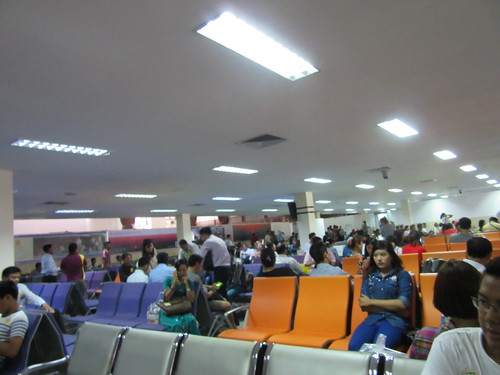 The Domestic Departure Hall at Mingalardon Airport, Yangon.
The Domestic Departure Hall at Mingalardon Airport, Yangon.
They were telling the truth – a ‘bell-boy’ carrying a board with the flight number circulated the waiting area announcing that the flight was ready for boarding about 90 minutes after we’d originally expected the call. We were loaded into one of the modern, air-conditioned transfer buses (I was rather sorry when they replaced the ancient ‘rattletraps’) and we drove off into the ‘International’ area of the apron, which initially puzzled me. But this was only to turn the bus around, after which we headed to a remote stand in the domestic area where an ATR42-series turbo-prop was waiting. When the doors of the transfer bus opened, I was hit by a wall of heat which took my breath away. Air Bagan were aware of the temperature and had provided a line of ground staff with umbrellas to shade the passengers walking the few yards from the bus to the rear airstairs on the aircraft. When the inevitable hold-up occurred as people found the correct seats, staff held the remaining passengers on the bus until the blockage had cleared.
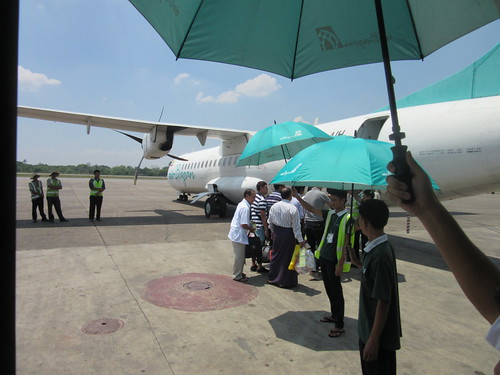 Umbrellas shaded passengers between the transfer bus and the aircraft, whilst technical ground staff sheltered under the wing.
Umbrellas shaded passengers between the transfer bus and the aircraft, whilst technical ground staff sheltered under the wing.
Soon we were airborne and heading for Mandalay at a cruising level of 19,000 feet. Air Bagan provided a simple but enjoyable lunchbox, a soft drink in a plastic cup and a tea or coffee before we landed at Mandalay on the longest runway in south-east Asia.
 Taxiing to a halt at Mandalasy International Airport.
Taxiing to a halt at Mandalasy International Airport.
We stayed in our seats whilst a transfer bus took away the 'leavers', returning with the 'joiners' a few minutes later. Before long, we were on our way to our second stop, Myitkyina, the capital of Katchin State. A new terminal building was being built next to the existing modest facilities.
 Myitkyina Airport: There appears to be lots of luggage to be loaded for the final leg.
Myitkyina Airport: There appears to be lots of luggage to be loaded for the final leg.
Once landed at Myitkyina, a lot of passengers left us but they were quickly replaced by passengers bound for Putao so we were full again for the last short leg to Putao.
As we approached Putao, mountains appeared on our left as a reminder that we are quite near Nepal but the airfield itself is located on a plateau (elevation 451 metres, I'm told). A crowd of people were standing outside the small terminal building - presumably passengers for the return ‘leg’.
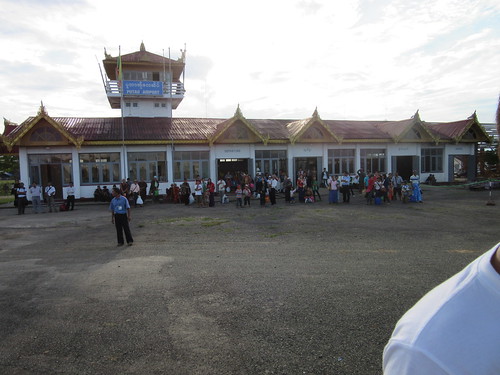 Putao Airport
Putao Airport
Rather than enter the terminal, we were directed to our left along an unsurfaced track, through a security check and into a large wooden barn with an immigration desk on the left where our local guide and tour leader Ngwa Phu Sar joined us as both my passport and my letter of introduction to Myanmar Immigration were carefully scrutinised.
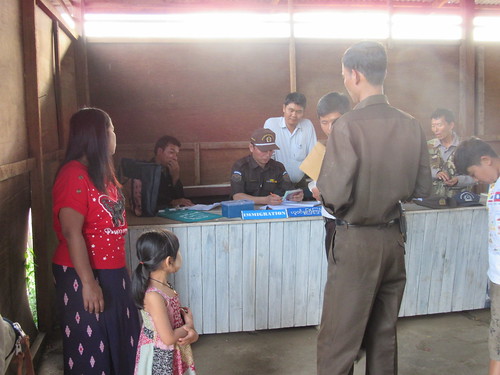 The Immigration Desk, Putao Airport.
The Immigration Desk, Putao Airport.
I noticed four basic check-in desks, one for each of the internal airlines serving Putao, and a single set of mechanical baggage scales which all the airlines share. After a few minutes, a group of baggage handlers appeared, struggling to get two loaded baggage trucks across the unsurfaced track. I quickly identified my bag and, after the baggage tag was checked against our receipt, we moved through a simple gate to an area full of three-wheeled bicycle taxis and a single Toyota SUV which was for us.
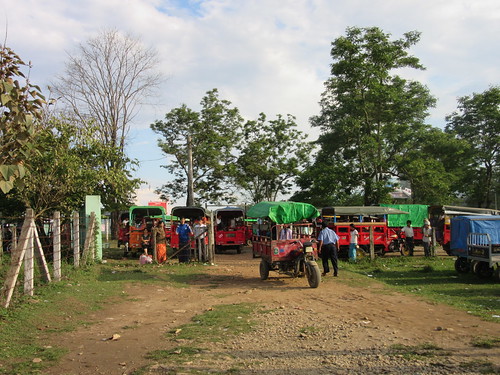 The public parking area at Putao airport.
The public parking area at Putao airport.
On the road from the airport to Putao itself, we passed a number of quite large wooden family houses then we crossed a couple of large streams on ‘Bailey’ bridges (there's an description of 'Bailey' bridges in Wikipedia here), finally turning left off the road leading to the town centre up a short, steep hill to stop at Putao Trekking House. It appeared that most of the staff were waiting to greet us. Cold towels and a ‘Welcome’ drink of grapefruit juice were provided. The grounds were attractively landscaped with a large main building to our right and a number of ‘cottages’ on our left, each with two ground floor rooms and two rooms on an upper storey. I was impressed by my ground floor room, provided with a large double bed (decorated with fresh flower heads and with a mosquito net above), writing desk and storage facilities. A second tiled room was fitted with a wash handbasin, European-style W.C. and shower.
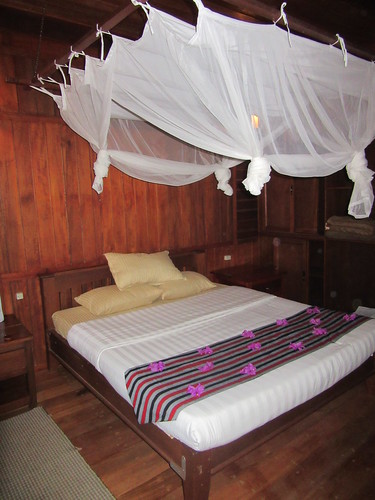 My comfortable bed at Putao Trekking House.
My comfortable bed at Putao Trekking House.
After ‘freshening up’, I accepted the offer of a conducted tour on foot around the town centre with the Tour Leader and Aung. We passed the main open-air market but as it was late afternoon this was closed. We looked at schools, municipal buildings and shops, tea-shops and restaurants. As the sky darkened, I managed an ‘arty’ shot of the distant snow-covered mountains (slightly marred by the overhead electric wires in the foreground).
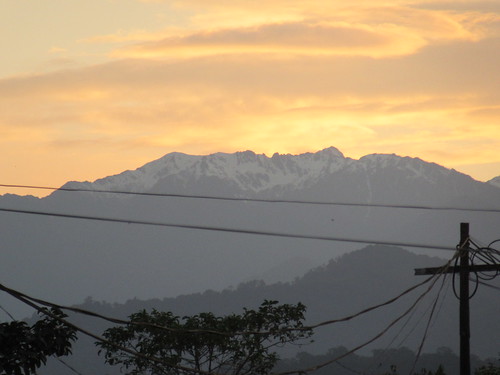 View of snow-topped mountains at sunset.
View of snow-topped mountains at sunset.
We walked back to Putao Trekking House who, at my request, had produced non-spicy food for my dinner, so I was able to enjoy my meal in the spacious restaurant with the Local Guide and Aung. Although I enjoy steamed rice, I can eat less than half of what my companions regarded as adequate. By this time, I was ready for bed. The local electricity supply goes off at about 9 o’clock in the evening (rooms were provided with re-chargeable lamps featuring a rectangular array of light emitting diodes to provide illumination when there's no mains) so I made myself comfortable in the bed and enjoyed an excellent night’s sleep.
Go to next post.
All my posts on this trip to Myanmar can be found here.
My pictures
By air from Yangon to Putao.
Putao Airport.
Putao.
Putao Trekking House.
[Text and pictures added 23rd Jun 2015]
On this trip, I visited the northernmost state of the Union of Myanmar, Katchin State, spending four days in and around Putoao. Wikipedia gives a simple introduction to Katchin State here.
Events of Tuesday 28th April 2015
I was picked up from Dr. Hla Tun’s house at around 09:15. In the car was the lady managing director of Sunbird Tours, Tin Htar Oo and my guide for the trip to Putao, Ye Aung Zaw (called simply 'Aung'). We set off into Yangon's heavy traffic. On the way to the airport, we dropped off Tin Htar Oo then carried on and arrived at Mingalardon’s bustling Domestic Terminal around 10:00, in plenty of time for the 11:30 Air Bagan flight to Putao. There’s very little in the way of automation and plenty of consultation of paper lists but our checked-in bags were accepted after weighing on old-fashioned weigh scales and on completion, we were issued with a little stick-on label which all the airlines use. Our Air Bagan labels had been marked in felt-tip pen ‘PBO’ (the ticketing code for Putao). We waited patiently in the departure hall until the public address system announced a one hour delay to our flight so we decided to go upstairs where there’s a reasonable buffet. We each had a leisurely soft drink and then went downstairs again but the information screen didn’t even mention our departure. Things looked more ominous when a couple of Air Bagan people came round with trays holding plastic cups of soft drinks and distributed small lunch boxes containing a cheese sandwich. I was somewhat mollified by the refreshment and then another announcement said that the delay would be one and a half hours – if true, better than I had feared.
 The Domestic Departure Hall at Mingalardon Airport, Yangon.
The Domestic Departure Hall at Mingalardon Airport, Yangon.
They were telling the truth – a ‘bell-boy’ carrying a board with the flight number circulated the waiting area announcing that the flight was ready for boarding about 90 minutes after we’d originally expected the call. We were loaded into one of the modern, air-conditioned transfer buses (I was rather sorry when they replaced the ancient ‘rattletraps’) and we drove off into the ‘International’ area of the apron, which initially puzzled me. But this was only to turn the bus around, after which we headed to a remote stand in the domestic area where an ATR42-series turbo-prop was waiting. When the doors of the transfer bus opened, I was hit by a wall of heat which took my breath away. Air Bagan were aware of the temperature and had provided a line of ground staff with umbrellas to shade the passengers walking the few yards from the bus to the rear airstairs on the aircraft. When the inevitable hold-up occurred as people found the correct seats, staff held the remaining passengers on the bus until the blockage had cleared.
 Umbrellas shaded passengers between the transfer bus and the aircraft, whilst technical ground staff sheltered under the wing.
Umbrellas shaded passengers between the transfer bus and the aircraft, whilst technical ground staff sheltered under the wing.
Soon we were airborne and heading for Mandalay at a cruising level of 19,000 feet. Air Bagan provided a simple but enjoyable lunchbox, a soft drink in a plastic cup and a tea or coffee before we landed at Mandalay on the longest runway in south-east Asia.
 Taxiing to a halt at Mandalasy International Airport.
Taxiing to a halt at Mandalasy International Airport.
We stayed in our seats whilst a transfer bus took away the 'leavers', returning with the 'joiners' a few minutes later. Before long, we were on our way to our second stop, Myitkyina, the capital of Katchin State. A new terminal building was being built next to the existing modest facilities.
 Myitkyina Airport: There appears to be lots of luggage to be loaded for the final leg.
Myitkyina Airport: There appears to be lots of luggage to be loaded for the final leg.
Once landed at Myitkyina, a lot of passengers left us but they were quickly replaced by passengers bound for Putao so we were full again for the last short leg to Putao.
As we approached Putao, mountains appeared on our left as a reminder that we are quite near Nepal but the airfield itself is located on a plateau (elevation 451 metres, I'm told). A crowd of people were standing outside the small terminal building - presumably passengers for the return ‘leg’.
 Putao Airport
Putao Airport
Rather than enter the terminal, we were directed to our left along an unsurfaced track, through a security check and into a large wooden barn with an immigration desk on the left where our local guide and tour leader Ngwa Phu Sar joined us as both my passport and my letter of introduction to Myanmar Immigration were carefully scrutinised.
 The Immigration Desk, Putao Airport.
The Immigration Desk, Putao Airport.
I noticed four basic check-in desks, one for each of the internal airlines serving Putao, and a single set of mechanical baggage scales which all the airlines share. After a few minutes, a group of baggage handlers appeared, struggling to get two loaded baggage trucks across the unsurfaced track. I quickly identified my bag and, after the baggage tag was checked against our receipt, we moved through a simple gate to an area full of three-wheeled bicycle taxis and a single Toyota SUV which was for us.
 The public parking area at Putao airport.
The public parking area at Putao airport.
On the road from the airport to Putao itself, we passed a number of quite large wooden family houses then we crossed a couple of large streams on ‘Bailey’ bridges (there's an description of 'Bailey' bridges in Wikipedia here), finally turning left off the road leading to the town centre up a short, steep hill to stop at Putao Trekking House. It appeared that most of the staff were waiting to greet us. Cold towels and a ‘Welcome’ drink of grapefruit juice were provided. The grounds were attractively landscaped with a large main building to our right and a number of ‘cottages’ on our left, each with two ground floor rooms and two rooms on an upper storey. I was impressed by my ground floor room, provided with a large double bed (decorated with fresh flower heads and with a mosquito net above), writing desk and storage facilities. A second tiled room was fitted with a wash handbasin, European-style W.C. and shower.
 My comfortable bed at Putao Trekking House.
My comfortable bed at Putao Trekking House.
After ‘freshening up’, I accepted the offer of a conducted tour on foot around the town centre with the Tour Leader and Aung. We passed the main open-air market but as it was late afternoon this was closed. We looked at schools, municipal buildings and shops, tea-shops and restaurants. As the sky darkened, I managed an ‘arty’ shot of the distant snow-covered mountains (slightly marred by the overhead electric wires in the foreground).
 View of snow-topped mountains at sunset.
View of snow-topped mountains at sunset.
We walked back to Putao Trekking House who, at my request, had produced non-spicy food for my dinner, so I was able to enjoy my meal in the spacious restaurant with the Local Guide and Aung. Although I enjoy steamed rice, I can eat less than half of what my companions regarded as adequate. By this time, I was ready for bed. The local electricity supply goes off at about 9 o’clock in the evening (rooms were provided with re-chargeable lamps featuring a rectangular array of light emitting diodes to provide illumination when there's no mains) so I made myself comfortable in the bed and enjoyed an excellent night’s sleep.
Go to next post.
All my posts on this trip to Myanmar can be found here.
My pictures
By air from Yangon to Putao.
Putao Airport.
Putao.
Putao Trekking House.
[Text and pictures added 23rd Jun 2015]
Subscribe to:
Comments (Atom)
